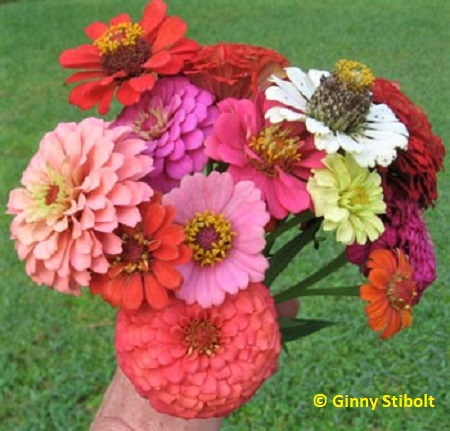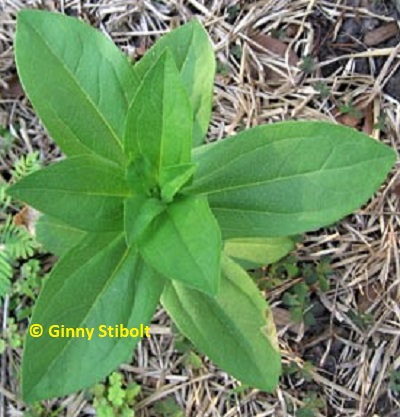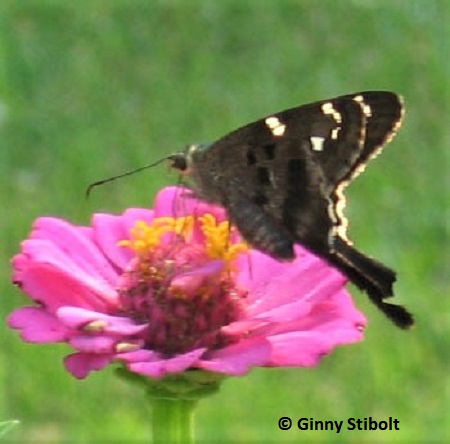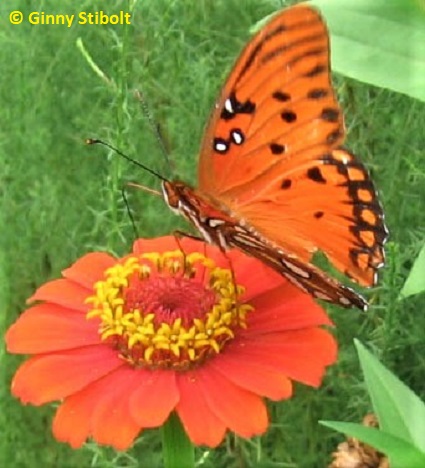Adventures of a Transplanted Gardener |
||||
Jewels of summer
| ||||
 A bouquet of zinnias shows the variety. |
Once the zinnia was brought to Europe, Linnaeus named it for Dr. Johann Gottfried Zinn, both a medical doctor and a professor of botany. Zinn wrote the first description of the zinnia and also wrote a detailed description of the human eye in 1765 that is still used today.
European plant breeders started cultivating the zinnia, carefully selecting for the best traits. Some of their cultivars were brought to the US in the late 1800s. Those early zinnias may have looked like the white zinnia in my bouquet in the photo with just a single row of ray florets. The zinnias with double, triple, or quadruple the number of ray florets were not developed until later.
The zinnia becomes popular
The real start of the zinnia's popularity began in the 1920s when Bodger Seeds Ltd. in California introduced a dahlia-flowered zinnia. John Bodger discovered a natural mutation in a field of zinnias he was growing and within the next few years selected the large, flat-flowered zinnias. These looked like the coral colored zinnia at the bottom of my bouquet.
 From the cotelyden leaves onward, the |
In the 1950s Ferry Morse Seed Company introduced the first known tetraploid zinnia, called ”State Fair”. Tetraploids have four sets of chromosomes, rather than the usual two and as a result, produce larger flowers, more ray florets, stronger stems, vigorous growth, and increased disease resistance. Last year one of my zinnias had three (!) leaves whorled around the stem instead of the normal pattern of two opposite leaves. You can see this in my photo. The flowers on this plant had many more petals, I mean ray florets, than all the others in that batch of plants. Had I been a breeder, this would have provided a great opportunity for me. I did save some of the seed and it's now mixed in with this year's crop. To save seed, let the flowers dry out on the plant and then harvest the whole flower head. Gently break the flower head and you should be able to extract the flat seeds from the center. Store in a cool dry place. I store my seeds in a sealed plastic container in the refrigerator.
Last year my zinnias did so well that I bought more seed this year. I bought a full ounce from American Meadows and this batch has produced much more variety in both color and form. I did not plant the whole ounce; the rest is in the refrigerator awaiting next spring. The germination rate will be lower the second year, but I'll supplement these with my collected seed. I've had more than enough for frequent bouquets from my cutting garden and to populate several meadow areas. The meadows have been butterfly havens through this hot, fairly dry summer.
When you cut the flowers for bouquets, cut the stem to just above the leaf crotch where new shoots are growing. This way you'll have two flowers for every one you cut. Remove the leaves from the stems of your cut flowers. The leaves get slimy when under water and the whole bouquet deteriorates rapidly when that happens.
You may want to cut back or stake the taller varieties so they don't lean too much. The standard size grows to four or five feet here in Florida. There are several dwarf cultivars that work better for borders or containers. Some seed companies offer uniform color and flowers, but I prefer the mixture with a good variety. In one meadow area all of the zinnias are pink. I have no idea how this happened, because elsewhere the colors include white, orange, magenta, red, coral, pale yellow, as well as pink.
 A long-tailed skipper sips from a pink zinnia. |
Butterflies: those other jewels of summer
Zinnias are a great addition to your butterfly gardens. If you deadhead the old flowers and keep them trimmed back, the flowering period is long, from early May to late fall. The fall bloomers such as goldenrod will then take the lead role in your butterfly gardens.
Butterflies favor plants like zinnias for their nectar sources because the flower head, or inflorescence, provides a good landing platform and many sources of nectar. Plant zinnias in large groupings because butterflies are nearsighted and the mass of color will draw them in. My hummingbirds also work the zinnias.
Plan for a zinnia garden next year. The resulting the eye-popping colors of both the flowers and the butterflies will be your jewels of summer.
(Update: I haven't bought zinnia seeds in many years, but after editing this article, maybe it's time to add these cheerful plants back into our gardens.)
Resources:
· American Meadows offers mixed wildflower seeds, but
I like more control of individual species such as zinnias: www.americanmeadows.com
· Harris Seeds has a mix of "Cut & Come Again
Zinnias: www.harrisseeds.com
· Burpee offers both mixed and single color zinnias.
They have just about every other type of seed as well: www.burpee.com
· Floridata.com's plant profile of zinnia: www.floridata.com/ref/Z/zinn_ele.cfm
Ginny Stibolt is a life-long gardener, a botanist, a naturalist, and a garden writer. You may contact her or read more of her articles posted on her website: www.greengardeningmatters.com.
Copyright Ginny Stibolt


